Thursday, February 28, 2019
Ingredients for a Successful Career in Social Work
from The New Social Worker Online — the professional social work careers magazine https://ift.tt/2NyBowC
Social Work Month 2019 - "Thank You" and Join Us for Six Core Values of Social Work, Leadership Messages
from The New Social Worker Online — the professional social work careers magazine https://ift.tt/2Xvbqi8
Lessons from the BBC’s R&D team on connecting with young audiences
from World News Publishing Focus by WAN-IFRA - World Association of Newspapers and News Publishers https://ift.tt/2NAlX74
Antique jewelry fraud: 11 ways to protect yourself online.
If you’re part of the antique jewelry Instagram community then you already know that our little corner of the world is having a huge problem with antique jewelry fraud right now.
What do I mean by online antique jewelry fraud? It’s when a piece of antique jewelry for sale online turns out to be fake in some way: either it’s a reproduction (a newer piece made to look old) it’s not all original (parts of it aren’t old) or it’s just not what it says it is (fake stones, replacement parts, etc).
Antique jewelry fraud can be an accident: unintentional ignorance on the part of an immature or inexperienced online seller who just doesn’t know enough.
from Diamonds in the Library https://ift.tt/2GPt0IP
Wednesday, February 27, 2019
Discover Scuba Diving: Try Before You Commit
Many prospective divers are apprehensive about dipping into the underwater. Luckily, many dive organizations offer a Discover Scuba Diving (DSD) course, which aims to dispel common misconceptions about scuba diving under professional guidance. Signing up for a DSD helps people determine whether diving is right for them in a closely supervised environment.
Taking a Discover Scuba Diving course
Dive schools only allow students over 10 years old to take the course. Instructors typically conduct the class in a shallow, sandy area with a maximum depth of 18 feet (6 m). The instructor will offer one-on-one focus, conducting basic skills and preparing students for the ocean environment. Organizations stress that the DSD is not a qualification course. You will not be allowed to dive alone after the one- to five-hour session. In fact, many people decide to conduct the experience multiple times, gaining confidence in a one-on-one environment. Subsequent open-water dives may include other divers, however, once people have finished their first DSD. May DSD divers progress on to an open-water course after enjoying the session.
What should you bring on your DSD?
Most dive schools will supply prospective students with all necessary diving equipment, but you should consider buying your own mask. While fins, wetsuits and other accessories are somewhat interchangeable, a foggy or odd -dive school mask can ruin your entire experience, especially before you learn to clear it of water or defog it.
What will you learn?
Students in a DSD class learn plenty of facts and figures about the underwater world and scuba diving. Instructors particularly stress the fundamentals, such as equalization, breathing and hand signals underwater. While the instructor or DSD leader will constantly monitor your buoyancy, it is crucial that you understand how to equalize the pressure on your body and breathe in the right way. You’ll learn basic signals such as ‘ok,’ ‘go up,’ ‘slow down,’ and ‘I have a problem,’ to help avoid any potential miscommunication issues.
Dependent on your instructor, each person can enjoy a variety of different learning techniques. These variations can encourage them to progress through the diving courses. Because of this, prospective divers should read reviews of dive schools and particularly the DSD reviews for any dive center you wish to patronize. If possible, visit the dive center before you commit to the Discover Scuba Diving course, especially if the activity is for children. Either way, a DSD can be a great entry into what may turn into an obsession.
The post Discover Scuba Diving: Try Before You Commit appeared first on Scuba Diver Life.
from Scuba Diver Life https://ift.tt/2VnewTt
Tuesday, February 26, 2019
What I’m reading: Vol. 108.
Hello, my darlings!
February turned out to be a pretty crazy month around here! I managed to come down with a killer cold between my Miami trip and my Tucson trip, so I felt like I was out of commission for almost a full month, between packing, traveling, unpacking, being sick, packing, traveling again, and then recovering! (There should be one more mention of “unpacking” but my suitcase is definitely still not yet empty, so I have to leave that one off the list for now. I’ll do it eventually.
Traveling while still dealing with my new health situation was definitely an adventure. I usually use that word in a positive way, but not this time.
Continue reading What I’m reading: Vol. 108. at Diamonds in the Library.
from Diamonds in the Library https://ift.tt/2NwKEkN
Monday, February 25, 2019
Underwater Robot Delivers Baby Corals to the Great Barrier Reef
Stewards of the Great Barrier Reef are working toward greater resilience to climate events with help from some ground-breaking technology: and an underwater robot is delivering corals
Ecology and technology have joined forces to give nature a helping hand by using an underwater robot to deliver heat-tolerant coral larvae directly to the Great Barrier Reef. This is the first small-scale pilot of a new technique that researchers hope will help restore and recover coral reefs.
In a first for the world, an underwater robot has helped scientists repopulate parts of the Great Barrier Reef by dispersing microscopic baby corals (coral larvae) during this year’s mass coral spawning event.
Underwater robot transplants baby corals
Southern Cross University’s professor Peter Harrison and Queensland University of Technology (QUT)’s professor Matthew Dunbabin trialed the initiative on Vlasoff Reef, near Cairns in north Queensland, after winning a $300,000 grant from the Great Barrier Reef Foundation (GBRF).
Professor Dunbabin engineered QUT’s RangerBot (previously used to hunt out and kill crown-of-thorns starfish, into LarvalBot specifically for Harrison’s coral-restoration project.
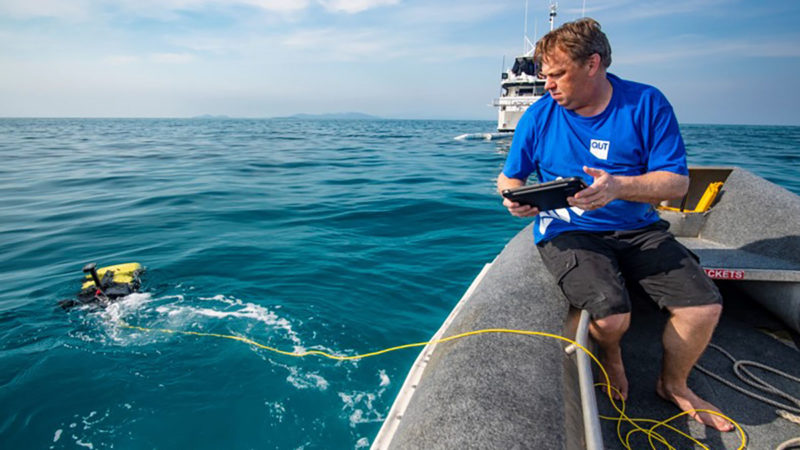
Dunbabin programs the LarvalBot (Photo credit: Gary Cranitch)
The project builds on Harrison’s successful larval-reseeding technique piloted on the Southern Great Barrier Reef in 2016 and 2017, which in turn followed small-scale trials in the Philippines.
“This year represents a big step up for our larval-restoration research,” says Harrison. “It’s the first time we’ve been able to capture coral spawn on a bigger scale using large, floating spawn catchers, then rearing them into tiny coral larvae in our specially constructed larval pools and settling them on damaged reef areas.
With further research and refinement, this technique has enormous potential to operate across large areas of reef and multiple sites in a way that hasn’t previously been possible,” he adds.
“We’ll be closely monitoring the progress of settled baby corals over coming months and working to refine both the technology and the technique to scale up further in 2019.”
How does it work?
Setting out larval pool floats (Photo credit: Biopixel)
With a current capacity to carry around 100,000 coral larvae per mission and plans to scale up to millions of larvae, the robot gently releases the larvae onto damaged reef areas allowing it to settle and, over time, develop into coral polyps or baby corals.
“During this year’s trial, the robot was tethered so we could monitor it precisely, but future missions will see it operate alone and on a much larger scale,” says Dunbabin.
“Using an iPad to program the mission, a signal is sent to deliver the larvae and it is gently pushed out by LarvalBot. It’s like spreading fertilizer on your lawn.
The robot is very smart. It glides along and we target where the larvae need to be distributed so new colonies can form and new coral communities can develop.”
The project’s future
This project builds on work by Dunbabin, who developed RangerBot to help control the coral-killing crown-of-thorns starfish that is responsible for 40 percent of the reef’s decline in coral cover.
“It’s exciting to see this project progress from concept to implementation in a matter of weeks, not years,” says Great Barrier Reef Foundation managing director Anna Marsden. “The recent IPCC report highlights that we have a very short window in which to act for the long-term future of the reef, underscoring the importance of seeking every opportunity to give our reefs a fighting chance.”
Following the success of this trial run in 2018, the researchers plan to fully implement their challenge-winning proposal in 2019.They will build even larger spawn-catchers and solar-powered floating larval incubation pools and design them to rear hundreds of millions of genetically diverse, heat-tolerant coral larvae to be settled on damaged reefs through a combination of larval clouds and LarvalBots.
The post Underwater Robot Delivers Baby Corals to the Great Barrier Reef appeared first on Scuba Diver Life.
from Scuba Diver Life https://ift.tt/2Te9NpT
Sunday, February 24, 2019
Supervision for Social Work Licensure: 12 Considerations
from The New Social Worker Online — the professional social work careers magazine https://ift.tt/2IBLkGQ
Make Your Competition Green with Envy

Make your competition green with envy this March! Valentine’s Day has come and gone, but don't miss out on the next opportunity of St. Patrick’s Day (March 17). With a bit of luck you can have your salon or spa decked out in green and welcome clients with clever incentives throughout the month of March.
Stand Out Merchandising —
While green is the color of shamrocks and leprechauns, emerald green is also the color du jour. We love this sophisticated jewel tone used throughout the salon, try small bouquets of live clover and lavender, mix-in merchandising elements such as clover shaped point of sale signs.
Go Green —
Green is the traditional symbol for sustainability and environmentalism. Create a “green” email campaign that highlights your salon’s sustainability efforts, or use clovers as an accent to reference the green-themed holiday.
Point of Sale Signs —
Tell your story clearly with themed point of sale signs or shelf talkers mixed into retail displays. Point of sale signs clearly state prices, products, packages, or specials you wish to highlight which both informs and encourages purchase.
Fresh Flowers —
We love to use fresh flowers mixed into displays - for such a little cost, fresh small bouquets in varying mini vases filled with pink or red roses or peonies add zest to any retail display.

Few small beauty business owners focus on retailing, yet retail product sales have the potential to support service revenue and increase profit margins. Considering retail has a much higher profit margin than services, focusing on a retail strategy can increase the bottom line and salon success. We have assembled a list of tips designed to attract customers and increase retail sales:
No1- Sell products you believe in
Sell the products used during services in the retail area of your salon or spa. If you’re passionate about a product or a brand and genuinely believe in it's performance, it will be evident. Clients are far more likely to purchase a product if recommended authentically. A salon that is lucky enough to co-brand with a prestige hair or beauty brand inherits associated recognition and trust.
No2 - Demonstrate and display products
Product demonstrations allow you to show off your expertise as well as a product's performance. Rather than talk about the finisher you’re using on the client’s hair, hand them the product to examine for themselves. Let them touch and smell it - creating a tangible connection. Ideally, every appointment should conclude with customized product recommendations.
No3 - Product Recommendations
Selling retail is simply equipping your clients with the products required to recreate their new look at home themselves. Style maintenance is the last step of your salon service and contributes enormously to client satisfaction. As a professional stylist, your product recommendations create both loyalty and trust.
Retail Tip: Every time you sell a client retail product, client retention (for that client) goes up 30%!
No4 - Tempt customers with a first time discount
Even a small discount (10%) may be enough to sway a client into purchasing a product for the first time. Casually mention that you’re able to offer a first time discount if they express an interest in the product or compliment it as you’re using it. Keep in mind the potential of future repurchase profits.
No5 - Window displays
Regularly freshen-up your window displays to match seasonal changes and trends. Walk or drive-by traffic will be drawn in by new, interesting displays. Dress up your windows to match the occasion and include retail product in your displays to entice and communicate your product offerings.
No6 - Keep displays neat and inviting
Organized, creative, colorful product displays draw the eye are much more likely to tempt curious clients. Create a boutique environment by investing in details that make your retail area standout.
Retail Tip: The first place guests naturally look when they enter a salon is to the right, so merchandise products on a display table to the center-right of the door where clients walk in.
No7 - Let customers touch and try products
For beauty retail products it’s important that clients be able to touch and try the products before purchase to guarantee satisfaction. Offer "testers" of every item you sell from eye shadow to fragrance – few will be able to resist! This applies to hair tools as well; display a "tester" appliance allowing potential consumers to hold it, feel the weight, and get an overall 360° view.
Retail Tip: If the product is stocked below or behind the display it encourages clients to pull and purchase. Cha-ching!
No8 - Pick products with obvious selling points
It’s human nature to be curious and it’s hard to resist trying a new lip shade, whiff a scent, or browse pretty objects. In addition to salon retail, mix in seasonal merchandise such as headbands, clips, makeup, jewelry, cosmetic bags and greeting cards (perfect accompaniment to a salon gift card). Unique retail items displayed and merchandised add to a guest's "salon experience".
No9: Try me station
Create a "Try Me" Station to encourage clients to test products. The station should be located at a mirror with a chair and a duplicate set of testers, cotton balls, tissue and Q-tips. Encourage testing with a "try me" sign at the station.
No10 - Point of sale signage
Point of sale signage, or shelf talkers, mixed into retail displays both inform and encourage purchase. Signage should be designed to clearly communicate product attributes, ingredients and price.
No11 - Loyalty cards or points
Set up a retail reward program - offer rewards when clients spend over a specific dollar amount on retail products or buys a specific number of retail products. This encourages guests to purchase retail from your salon, and your salon only. Salon management software helps you track client’s spending and reward loyalty.
No12 - Hold product parties
Boost retail sales by throwing an after-hours "invite only" product party. This is a fun and social way to reward loyal clients, as well as introduce them to the latest retail launches. Tempt clients with free treatments, mini-spa services, or discounts on products purchased the night of event. Give-away product samples or discount coupons off their next salon retail purchase.
No13 - Front desk retail follow up
Even if you or your salon stylist has spoken enthusiastically about a product, it’s the front desk that often seals the deal; set up a system that includes a retail follow-up at check out.
No14 - Team competitions
Run an informal retail competition between your employees – the stylist that sells the most each week gets a free product of their choice – or an alternative cash prize.

from Beauty Business Blog https://ift.tt/2Teq3qJ
Thursday, February 21, 2019
Share jewelry book recs on #IGJewelryBooks.
If you like jewelry and you like books (and you probably do if you’re here reading this) then I bet you also love JEWELRY BOOKS. I have good news for you.
There’s a new hashtag in town: #IGJewelryBooks. It has one mission: jewelry book recommendations.
The hashtag was launched just a few days ago by Manor Jewels. In her inaugural #IGJewelryBooks post, @ManorJewels explained her motivation for the hashtag is education:
[]…We must do a better job of educating one another: Whether that’s sellers educating followers, collectors educating sellers (it does happen and it’s always wonderful to have snippets and insights shared!), buyers asking for clarification and getting clear, concise, and accurate information. Whatever we can do, let’s do it!”
I think this is absolutely fantastic: the more that jewelry lovers know, the better for everyone in our community.
Continue reading Share jewelry book recs on #IGJewelryBooks. at Diamonds in the Library.
from Diamonds in the Library https://ift.tt/2Xh055l
The Best Scuba Diving in Oman
Oman is a relatively undiscovered dive destination. Here, divers will find warm water, pristine dive sites and plentiful marine life — all without crowds of divers or boats. The country is rich in natural beauty as well, with vast deserts and wadis to explore, plus bustling souks and the beautiful waterside capital, Muscat. Despite being a new destination for liveaboard diving, Oman has three great areas to choose from: the Daymaniyat Islands, Musandam Peninsula and Hallaniyat Islands. Each has unique dive highlights and divers can visit on a 7- or 10-night liveaboard safari. Marine life includes whale sharks, molas, mobula rays, whales, sea turtles and more. Much of the best scuba diving in Oman is suitable for divers of all levels.
Oman’s waters are warm year-round, ranging from 75 F in winter to 86 F in summer (24 to 30 C), meaning a 5 mm wetsuit should be sufficient for most divers. The best time to dive Oman is from October to May, as the water and air temperatures are ideal for diving and land excursions, and it’s also whale-shark season. Fans of sea turtles should visit during May and June to watch green and hawksbill turtles nesting on island beaches.
The local language is Arabic, but most Omanis speak very good English. The local currency is the Omani rial and bear in mind not all ATM machines will accept cards from foreign countries. Here are our picks for the best scuba diving in Oman.
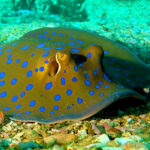
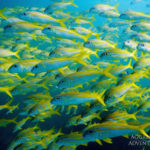
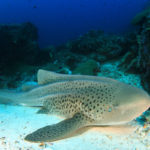
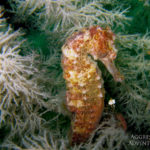
Daymaniyat Islands
Where is it: North of Muscat
What makes it special: This tiny archipelago of rocky islands was the first marine reserve created in Oman. Coral reefs surround the islands, which are an important area for nesting sea turtles. Deep-ocean upwellings attract large schools of fish, plus zebra sharks, whale sharks and reef sharks. This destination is so special that the government closes the marine reserve for part of each year to protect it and allow the marine life to flourish.
Details: Dive depths are up to 100 feet (30 m) and the dives are suitable for all divers, from open-water divers with no logged dives upwards.
When to go: May to October
Musandam Peninsula
Where is it: Oman’s northernmost region
What makes it special: This peninsula in the northmost reaches of Oman is known for fantastic scuba diving thanks to nutrient-rich waters and diverse marine life. Musandam is famous for whale sharks, which swim in the shallow waters here, plus colorful coral reefs, sea turtles, rays, mola molas and numerous critters. Two of the most popular dive sites, The Caves and Lima Rock, offer the chance to explore tunnels and underwater chambers, plus coral-encrusted walls. The Caves is a great place to search for resting sharks, while Lima Rock has large schools of tuna and jacks.
Details: Dives are suitable for all divers, from open water divers with no logged dives upwards.
When to go: April to June
Hallaniyat Islands
Where is it: South of Muscat
What makes it special: If you’re looking for a remote and undiscovered dive destination in Oman, the Hallaniyat Islands fit the bill. These barren islands lie south of Muscat and are home to small fishing communities and great dive sites, only accessible by liveaboard. There are several wreck dives in the area. Additionally, marine life highlights include manta rays, pods of dolphins, humpback whales and even sperm whales.
Details: The diving in the remote Hallaniyat Islands is more suited to experienced divers. Be sure to take all the dive-gear spares you need, as you will struggle to find replacements on the islands.
When to go: September to May
Salalah
Where is it: Southern Oman
What makes it special: Salalah is a great addition to your Oman diving itinerary before or after a liveaboard safari. It is harder to reach than other dive areas but is well worth the effort. Visit in summer and you can enjoy diving within seasonal kelp forests at Mirbat. These forests appear at the coral reef during this season only, due to cool upwellings, and die back by October each year.
Details: The dive sites of Salalah are mostly accessible via four-wheel-drive vehicles. There are some boat trips available to the area.
When to go: During the summer months
Divers and writers at LiveAboard.com contributed this article.
The post The Best Scuba Diving in Oman appeared first on Scuba Diver Life.
from Scuba Diver Life https://ift.tt/2tzo7ei
Wednesday, February 20, 2019
Focus on Your Followers, Not the Number of Followers

Instagram is back at it again. I have had many clients say to me "OMG WHERE DID ALL MY FOLLOWERS GO?!" Guess what?
You shouldn’t care how many followers you have now, or how many you lost last week, or how many you're gonna gain this week.
When you spend your time and energy focusing on the number of followers you have - or the followers you don't have yet - you forget to pay attention to the community that's already right in front of you!
Instead of obsessing over the number of followers, obsess over the clients and potential clients you already have on the other side of the screen.
The clientele who are already taking the time to engage with your posts are the fans to focus your energy on through your created content, your products and services. The fans are right there in front of you, just waiting for you to connect. Focus on creating content for them, THAT is what matters - NOT your follower count.
Tired of consistently posting to your business social media accounts? Tired 😵 of coming up with new content every day of the week? Try SMM @beautymarkmarketing
Social Media is IT in terms of a place to focus intention 🎯 on marketing your business in 2019. It will add an additional funnel 🌪 of new clients to book into your orbit! Who doesn’t want that?
FB/IG DAILY POSTING
CUSTOM HASHTAG STRATEGY
+ ADVERTISING SERVICES
=$499/MO
We set up target audience and boost high performance posts and/or PPC Advertising on FB and Instagram. *Actual advertising budget decided by client and paid through FB Ads Manager.
Add a Custom Monthly Promotion for $400
6 month minimum commitment required.
For more info DM or contact me at kierna@beautymarkmarketing.com
Schedule a chat with me at calendly.com/beautymarkmarketing
from Beauty Business Blog https://ift.tt/2XfwVU0
Tuesday, February 19, 2019
Best Wreck Diving in Europe
In the last of our six-part series on the world’s most dive-able wrecks, we’re highlighting the best wreck diving in Europe. (Check out our stories here on wreck diving in Asia, Africa, the Middle East, the United States and Caribbean). While divers have, unfortunately, removed or salvaged parts from some wrecks, many are still in the same condition as when they sank. Equipment, tools and everyday objects often appear frozen in time from the moment the ship down. If you’re looking to round out your warm-water wreck diving with some worthy entrants in temperate waters, look no further than our picks for the best wreck diving in Europe.
The Zenobia

Trucks on the Zenobia wreck
Where: Lanarka harbor, Cyprus
The MS Zenobia was a roll-on-roll off car ferry that capsized and sank on its maiden voyage in June 1980 with no casualties. It was carrying over 120 vehicles, many of which are still on the wreck. Experienced wreck divers can utilize many penetration points, and novice divers can cruise along the starboard side of the ship at around 50 feet (16 m).
Maximum depth is 138 feet (42 m) with the shallower parts of the dive starting at 52 feet (16 m). Water temperature ranges between 63 and 82 F (17 to 28 C) from February to August, with the main diving season falling between March and November.
SS Excellent
Where: Gibraltar
The SS Excellent steamer was at anchor in 1888 in Gibraltar Bay with a cargo of fruit bound for the United States. A strong current caused it to drag anchor and the ship subsequently collided with the Saint Asaph and the Memling. It sank near the Detached Mole (a breakwater in Gibraltar Bay).
The damage from the collision is visible in the wreck’s midsection. The anchor is located near the starboard side and while the wreck is partially buried, divers can clearly see the two-cylinder steam engines, the boilers, one furnace, and a large four-bladed propeller. Penetration is possible, although visitors should take care as strong weather conditions have moved the wreck in recent years, making penetration a bit trickier and somewhat dangerous.
The stern lies at 82 feet (25 m) while the bow is at 92 feet (28 m). Water temperature ranges from 57 F (14 C) in March to 72 F (14 C) in August.
Blockship Tabarka
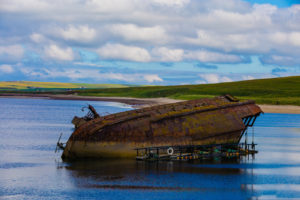
A blockship at the entrance to Scapa Flow
Where: Scapa Flow, Scotland
Part of the underwater ship cemetery of Scapa Flow, the Tabarka was one of three vessels scuttled in Burra Sound to prevent the enemy’s access Scapa Flow bay. The wreck is upside down and has multiple entry points with vibrant marine life.
Although the Tabarka only has a maximum depth of 52 feet (16 m), it is an advanced dive due to strong currents. The wreck is only accessible at slack tide. Water temperature ranges between 39 and 57 F (4 to 14 C) from April to September so a drysuit is a must.
Pietro Orseolo
Where: Glénan Islands, France
The Pietro Orseolo was an Italian cargo vessel that transported food, weapons and tools for the Germans in WWII. It sank near Penfret Island in 1943. Some of the holds have disintegrated and many of the upper parts have been levelled, making penetration only suitable for extremely experienced wreck divers with the proper skills and training. The outside of the wreck, however, still offers much to see. A sea-fan clad propeller shaft, three caterpillar trucks, a large engine and connecting cables between the front and back of the vessel are all worth exploring.
The Pietro Orseolo sits slightly tilted toward starboard at between 56 and 100 feet (17 to 30 m). Water temperature ranges from 48 F in February to 61 F in August (9 to 16 C), so you’ll want a drysuit whenever you visit.
Dellec wreck
Where: Brest harbor, France
The Dellec is an unidentified wreck from WWII. German occupation authorities armed and positioned this 72-foot (22 m) barge to defend Brest against an Allied seaborne assault. It is unclear how it sank. The wreck is mostly intact, sitting upright on a sandy bottom. Presumably wooden, the top decking has rotted away and left the metal framework and parts of the interior exposed. There are large rolls of chain on the stern and bridge and weapon-control stations on each side of the hull. The amidships has four spectacular torpedo tubes as well. Penetration is easy due to the absence of the deck. Inside you can see large rolls of cables and wire, control panels, pipes, the crew’s washroom and the compressor used for torpedo launches.
The Dellec sits at 26 feet (8 m). Water temperature ranges from 48 F in March to 61 F in August (9 to 16 C). You’ll definitely want a drysuit.
SS Empire Broadsword
Where: Normandy, France
The SS Empire Broadsword sank nearly a month after D-Day. It struck two mines and became airborne thanks to the explosion, which subsequently broke the ship’s back and sank it. The wreck sits on the starboard side. Divers can penetrate the engine room, bridge and boiler room, but strong tides, gales and the shallow depth have weakened the wreck’s structure. Outside, divers can see a huge rudder, deck guns, ammo and anti-aircraft guns. The wreck sits between 49 to 88 feet (15 to 27 m) in water ranging from 45 F in March to 66 F in August (7 to 19 C).
SS Norfolk
Where: Normandy, France
The SS Norfolk struck a mine while on active duty off the coast of Normandy. It then became a blockship for the American military off Omaha Beach. The wreck is upright and divers can penetrate the engine room and accommodation areas. The wreck sits between 46 and 66 feet (14 to 20 m) meters in water ranging from 45 F in March to 66 F in August (7 to 19 C).
Le Rubis
Where: Cap Camarat, France
The French Navy sank the Le Rubis submarine in 1958 as a sonar target. Divers can see the masts floating in mid-water, the compressed air cylinders used for the ship’s buoyancy inside the wreck, three trapdoors and the protrusions that held landmines while the vessel was in action. There is a platform at the front of the turret thought to be a lookout point while the ship was on the surface. In many areas the metal sheeting has decomposed, exposing the valves and pipes underneath. Divers can enter the central trapdoor but it is extremely narrow and only one person can enter at a time. Only extremely experienced and skilled divers should attempt penetration.
The Le Rubis sits between 104 and 130 feet (32 to 40 m) and there is a near-constant current that can be quite strong. Water temperatures range from 53 to 68 F from January to August (12 to 20 C).
Um El Faroud

The deck of the Um el Faroud (CC BY-SA 3.0)
Where: Malta
The Um El Faroud was an oil tanker from Libya. It was scuttled in 1998 to form an artificial reef off the coast of Wied Iz Zurrieq after being damaged in an explosion three years earlier. The wreck sits upright in two parts, broken by a winter storm in the 2005-2006 season. The doors and windows are gone, and entry and exit holes have been cut into the wreck for easier penetration by experienced wreck divers. Divers can find a brass memorial plate dedicated to the dockyard workers who died in the explosion that damaged the Um El Faroud on the wreck.
The funnel of the wreck sits at 49 feet (15 m) while the propeller is at 118 feet (36 m). Water temperature ranges from 57 F in March to 75 F in August (14 to 24 C).
Entella
Where: Italy
The Entella avoided a torpedo hit on April 10, 1943, only to become stuck on a shoal and subsequently struck and sunk by a torpedo the next day. As it was obstructing navigation for other vessels, further explosions finished the job and sank it all the way. . The wreck is mostly twisted metal and the remainder of the superstructure. The coal the ship was carrying is thickly scattered along the bottom around the wreck. Due to the damage the vessel received, lots of light penetrates the wreck, making it for underwater photographers. The wreck sits between 46 and 59 feet (14 to 18 m) in water ranging from 55 to 72 F (13 to 22 C) from February to August.
The post Best Wreck Diving in Europe appeared first on Scuba Diver Life.
from Scuba Diver Life http://bit.ly/2V4qAZN
Monday, February 18, 2019
Self-Care A-Z: Professional Self-Care for Social Workers, Part 2—Boundaries & Balance
from The New Social Worker Online — the professional social work careers magazine http://bit.ly/2DOBsUB
Sunday, February 17, 2019
The Reef Rescue Network
The nonprofit Perry Institute for Marine Science (PIMS) works to protect the oceans through research that both informs the public and encourages action. The agency’s programs focus on improving understanding of the issues facing the oceans. They work with governments to develop management strategies and improve decision-making and educating the next generation of marine scientists. To increase capacity for coral restoration, PIMS created the Reef Rescue Network. This partnership between coral-reef scientists and local stakeholders includes community organizations, NGOs and dive operators.
What is the Reef Rescue Network?
The Reef Rescue Network coordinates coral-nursery establishment, maintenance, management, outplanting and monitoring with its partners. Specifically, the agency helps develop and implement criteria for restoration, makes nursery-site selections, harvests coral from source populations, grows corals in nurseries, outplants corals to reefs, and monitors successful restoration at multiple scales, from individual corals to ecosystem health. Work also includes research for breeding and dispersal of coral larvae and research on long-spined sea urchins, parrotfish and other key species, as well as reef surveys to help create Marine Protected Areas.
During 2018, the Reef Rescue Network established 30 coral nurseries throughout the Bahamas, with plans to extend further in the Caribbean.
Coral nurseries
Coral nurseries are an important component to marine conservation, as they provide a collection of species that scientists can add to the reef to help regenerate stressed or damaged areas. Coral’s slow growth rates were once thought to limit the ability to restore reefs, however, scientists now know that corals grow at different rates and, in favorable conditions, can grow much faster than in natural conditions on reefs.
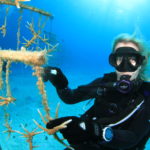
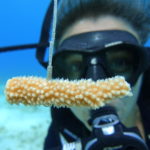

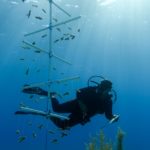
Over the last few years, conservationists have rejuvenated many reef areas with corals grown in a nursery, both creating and restoring habitat for marine life. Out-planted corals have even spawned, which is a huge indicator of the positive effects of this type of coral rehabilitation. By increasing the numbers of distinct parent genotypes through propagation and out-planting of nursery-grown fragments, sexual reproduction and recruitment are expected to have higher success rates. This will, hopefully, ultimately aide in the natural recovery of the species. Consideration of genetic factors is essential because long-term restoration success may be influenced by genetic diversity of restored-coral populations. Many different species of corals are growing in nurseries all over the world.
Nursery designs
Several nursery designs exist for growing corals, each with different benefits based on the location’s specific environmental conditions and project goals. Mid-water nurseries are successful for growing several species of branching corals, while other, experimental techniques such as micro-fragmentation and spawning show promise for a wide range of species.
Currently one of the most popular nurseries is the ‘tree’ design, which is anchored to the seabed and often made using PVC pipes, joints, rope and a float to keep it suspended in the water column. Once the corals have grown large enough (usually 6 – 12 months for branching corals), scientists can out-plant nursery corals on the reef. They may either place corals on the reef intact or they may cut fragments off to outplant with the original piece left to regrow. With each pruning, the remaining fragments grow faster.
PADI Reef Rescue Diver Specialty Course
PIMS has developed a PADI Reef Rescue Diver specialty course that dive shops throughout the Reef Rescue Network are teaching. To participate, you must be a certified open-water diver and at least 12 years old. The course takes one day and consists of knowledge development and two open-water dives at a coral nursery.
This specialty intends to familiarize divers with the skills, knowledge, planning, organization, procedures, and techniques involved with coral-nursery diving. PADI instructors educate divers about coral nurseries, including essential facts about coral reefs, threats facing corals, coral nurseries’ function and how to maintain coral nurseries.
What you will learn
- What corals are
- How corals feed and what gives them the most energy
- How corals reproduce
- Common types of corals in the Caribbean
- Why coral reefs are important
- The threats to coral reefs both globally and locally
- Steps to help protect and rehabilitate coral reefs
- The function of coral nurseries
- How to maintain a coral nursery
- Problems that can occur in a coral nursery and how to fix them
- How to outplant corals from a nursery back onto the reef
- How to choose a suitable out-planting site
- What the future for coral restoration and reef rehabilitation looks like
- About the Reef Rescue Network
Once certified you may volunteer throughout the Reef Rescue Network.
Contact training director and coordinator Hayley-Jo Carr. Follow PIMS’ work on Facebook or Instagram and Reef Rescue Network here and here.
The post The Reef Rescue Network appeared first on Scuba Diver Life.
from Scuba Diver Life http://bit.ly/2X9DMyc
Friday, February 15, 2019
Marine Species: Ghost Pipefish
Within the pipefish family, the handful of species known as ghost pipefish are quite special. Photographers and muck divers alike delight in seeing these small and often well-camouflaged fish. Most species tend to float head-down and feed on tiny crustaceans. Here we’ll look at four famous species of ghost pipefish.
Ornate ghost pipefish
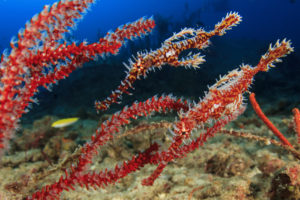
Ornate ghost pipefish
Also known as harlequin ghost pipefish, the ornate ghost pipefish is actually quite common. They are masters of camouflage, and can display a mix of black, yellow, red or transparent colors. These fish often hide in feather stars or sea fans, matching closely the color of their background. They make for spectacular photos with their spikes and color range. Divers can find them from the Red Sea to the tropical Indo-Pacific, mainly in shallow waters and often around reefs.
Robust ghost pipefish
Robust ghost pipefish are the largest in the family and can reach up to 7 inches (17 cm). They look quite similar to seagrass, which makes them difficult to spot. They usually float around with seagrass and also rock back and forth with water movement, just like seagrass. Colors vary from brown to green to yellow. Divers can find them from the Red Sea to the tropical Indo-Pacific, mainly in shallow waters and often around reefs.
Velvet ghost pipefish
This one is a rare find and has not even been classified properly yet. Their body color, texture and shape mimics sponges, and they are usually brightly colored, from pink to red to purple. They live most commonly around sponge corals that they use to hide. Scientists know very little about this species and have yet to describe it. These are a rare find and you will usually see them around the Indo-Pacific.
Halimeda ghost pipefish
This is the smallest of ghost pipefish, reaching a maximum size of about 2.4 inches (6 cm). Its name comes from the algae Halimeda, as its body looks similar to the plant. It is usually green but can be red or white, resembling the algae it is using to camouflage. Divers can find them in the Western Indo-Pacific and Indian Ocean. They’re difficult to spot as they’re usually hovering motionless with an algae background.
The post Marine Species: Ghost Pipefish appeared first on Scuba Diver Life.
from Scuba Diver Life http://bit.ly/2DFUOLD
Wednesday, February 13, 2019
Divers Alert Network (DAN) Dive Safety Courses
Divers usually think of PADI, SSI, NAUI, BSAC, or a technical agency such as TDI or IANTD, when considering a dive-training agency. Aside from basic life-support courses in CPR/first aid and secondary care and O2 administration, however, few agencies offer courses specific to dealing with dive incidents, dive safety, marine-life injuries and decompression sickness. Although we often think only of the Divers Alert Network (DAN) as providing access to insurance, hyperbaric support in local communities and promotion of safe diving practices, they also offer specific training courses that benefit all divers, not just dive professionals. Here’s a rundown of the DAN dive safety courses you can take.
First Aid for Hazardous Marine Life Injuries
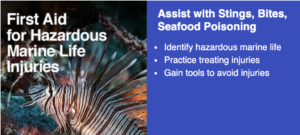
Would you know how to help your dive buddy if he had a jellyfish sting, sea urchin wound, coral scrape, bite or puncture wound? This course addresses these scenarios and more, and the specific first aid care you should offer. You’ll learn how to assess injuries, how to manage shock, how to treat envenomations and more. This course is essential for divers who enjoy tropical-water diving, particularly those who wear shorty wetsuits or none at all. Photographers who may get closer than intended to their subjects and the reefs can benefit as well.
Neurological Assessment

This course trains you to look for signs and symptoms of decompression illness. You’ll learn to record data that may help professionals diagnose if the diver is suffering from DCI following a scuba dive. The DAN field neurological assessment slate helps you asses memory recall. It also guides you through cognitive and motor assessments that help gauge more accurately if a diver needs hyperbaric treatment. This course is ideal for all active divers, but particularly those who dive in remote areas with limited access to dive medical professionals and a hyperbaric chamber.
Emergency Oxygen
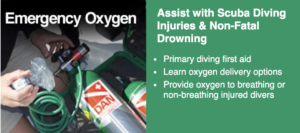
Oxygen delivery is always the first step when treating divers with suspected DCI or an arterial gas embolism (AGE). While most rescue divers learn about O2 delivery, many divers are unsure of how to administer O2 to several injured divers at the same time. Divers in buddy teams or groups may display the same signs and feel the same symptoms. Thus, the DAN Emergency Oxygen course addresses delivering O2 to divers at the same time from one unit. It teaches students how to prioritize who receives what via different delivery methods. This course is perfect for all active divers. It will particularly benefit those who dive with a buddy and not as part of an organized charter trip with professionals and O2 on site.
Diving Emergency Management Provider
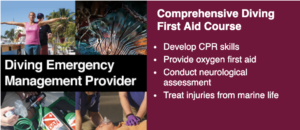
When diving accidents happen, they usually result in multiple injuries. This multi-faceted course combines the DAN First Aid course, Hazardous Marine Life Injuries, Neurological Assessment and Emergency Oxygen provider. It’s suitable for all active divers and dive professionals.
Diving First Aid for Professional Divers

This course encompasses information from the above courses, as well as CPR/first aid and secondary care. The course meets U.S. Occupational Safety and Health Administration (OSHA) guidelines for workplace CPR and first aid and is suitable for commercial, professional, scientific and aquarium divers.
DANs revised e-learning platform makes learning convenient and enjoyable, with embedded video and self-assessments. You will always have access to the latest guidelines and content when revisions are implemented. The courses can range from ½ day to two days.
Visit the website to find a DAN instructor or instructor trainer near you.
Disclaimer: This article and content is not intended to replace professional medical treatment. Always seek professional treatment if a diver is injured. These courses are not a substitute for excellent buoyancy control, good situational awareness and proper aquatic-life interaction.
The post Divers Alert Network (DAN) Dive Safety Courses appeared first on Scuba Diver Life.
from Scuba Diver Life http://bit.ly/2tmj7cC
Rappler CEO Maria Ressa Arrested on Cyber Libel Charges
from World News Publishing Focus by WAN-IFRA - World Association of Newspapers and News Publishers http://bit.ly/2SufuQW
Tuesday, February 12, 2019
HOW MUCH IS A CLIENT WORTH? THE TRUTH OF MARKETING ROI

Many beauty business owners have delusions of earning a $100,000+ a year income without spending any money to acquire the treasured asset - CLIENTS. Income-producing clients don’t come for free. What are you prepared to spend to acquire a $2,000 a year client? Acquiring new clients requires investment.
No Worthwhile Marketing is Free.
Merely throwing a Facebook page up and waiting for prospective clients to find your business is not marketing. Properly crafted, polished marketing requires time and money. Clients are assets, and marketing is a necessary investment for client attraction and business growth.
Set Your Marketing Budget.
Most beauty business marketing budgets are set between 4-7%, depending on the organization and size. Marketing has become necessary in an oversaturated market to create awareness of your beauty business brand, whereabouts, services and products. The key is to find the perfect percentage of marketing dollars necessary to maintain a stream of new and repeat clients.
Controlled Repetition is Key.
Work out an “awareness rhythm” that will continue to keep your salon fresh in the minds of your current and potential guests.
Analyze your Clientele.
What age group do you want to attract to your salon, and what age group are you attracting? More of what you have is easier to attract, but awareness to new markets can expand your market.
What Interests Your Clients?
An attractive loyalty program provides guests with perks and rewards starting on the first visit. Focus where you are going to get the strongest response.
- Gift with purchase (ex: free treatment w/service)?
- Discounts?
- Rewards?
Your Marketing is Only as Strong as Your Staff.
What promotions will your salon team support naturally? Marketing promotions that are easy to communicate are more successful every time.
Marketing ROI, marketing budget, beauty business clients, marketing budget, controlled repetition, clientele analyzation, salon staff support
from Beauty Business Blog http://bit.ly/2TKwRcU
Monday, February 11, 2019
Preserving America’s Underwater Battlefield: the Ashkhabad
Just off coastal North Carolina lies the Graveyard of the Atlantic. This World War II battlefield that serves as the final resting place for nearly 1,700 men. From January to July 1942, German U-boats sank dozens of Allied and merchant vessels off Cape Hatteras with relative ease. Each month, Scuba Diver Life and NOAA will partner to profile 12 different ships in the Graveyard of the Atlantic. This month, we’ll visit the Ashkhabad.
The Ashkhabad sinks
Originally named War Hostage, the Ashkhabad was built during World War I as a standard cargo ship. Following the war, it changed hands and names many times, and was refitted as an oil tanker. The Soviet State Shipping Line bought the tanker in 1934 and added a defensive bow gun as World War II began.
In April of 1942, Ashkhabad began traveling to Cuba from New York, escorted by a converted British trawler, HMT Lady Elsa. It was standard procedure during the war to sail a zigzag course in an effort to avoid U-boat attacks. Unfortunately, this tactic did not work for the Ashkhabad.
Traveling under the cover of darkness on April 30, 1942, the Ashkhabad passed southeast of Cape Lookout, North Carolina. Subsequently, a U-402 fired a single torpedo and hit the ship. The tanker sank in shallow water by its stern. The Lady Elsa safely rescued the entire crew.
The ship was scheduled for salvage, but when the USS Semmes (DD-189) came upon the floating wreckage, the crew was unaware of the intent to salvage. The Semmes had a standard order to sink all wrecks that posed a hazard to navigation, so it fired three shells into Ashkhabad. Not long after another trawler, the HMT St. Zeno, joined in the shelling, completing the destruction of the vessel. Once German U-boats left the area, the U.S. Navy and Coast Guard continued to clear the remains of ships posing hazards to navigation and the Ashkhabad was further destroyed.
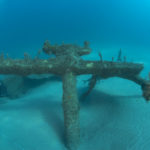
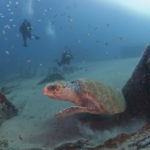
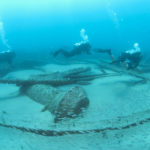
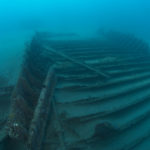
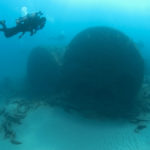
Diving the Ashkhabad
Today, the Ashkhabad sits in 55 to 60 feet (17 to 18 m) of water about 17 miles from Cape Lookout, North Carolina. Divers can access it easily from Beaufort or Morehead City. The wreck lies in the warm water of the Gulf Stream, making it a popular site for both fishing and diving. With an abundance of marine life, including many tropical fish, the Ashkhabad is also often home to loggerhead sea turtles.
Divers can not only enjoy the wreck’s beautiful marine, but they can also dive into World War II history as they survey the wreck site. Visibility at the site varies but can be over 100 feet (30 m), giving divers a great view of the large and widely scattered debris field created from the demolition of the site during the war.
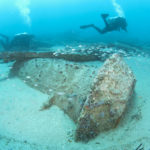
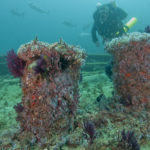
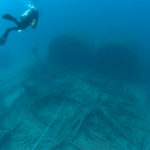
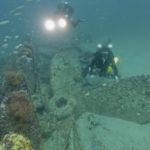

Distributed along the flat, sandy bottom, the Ashkhabad‘s remains are characterized by low relief. The highest points are the tops of the three massive boilers, located in the middle of the debris field. The ship’s large anchor lies away from the ship mostly intact and the ship’s spare propeller sits on the port side toward the middle of the wreck.
Over the years, NOAA has surveyed the site with divers and multibeam sonar to give researchers a detailed look at the features of the wreck site. From the data collected, the agency has produced site plans and dive slates to help divers navigate through the wreck site.
“The Ashkhabad is a great introductory dive for beginner divers, but also offers an opportunity for experienced divers to combine their love of history and marine life,” says Tane Casserley, a NOAA diver and Monitor National Marine Sanctuary’s research coordinator.
Although the Ashkhabad is not considered a war grave because all its crew survived, divers should still leave the wreck and its artifacts intact for future generations. Learn more about the Ashkhabad here.
An expanded sanctuary
In an effort to honor the service and sacrifice of those lost during the Battle of the Atlantic, in 2019 NOAA will release a draft proposal to expand the boundaries of Monitor National Marine Sanctuary. The proposal will include a nationally significant collection of shipwrecks that currently have little or no legal protection. The expansion would also establish the largest area designated as a World War II battlefield anywhere in the world.
To learn more about the proposal, click here.
By guest author Shannon Ricles, Monitor National Marine Sanctuary
The post Preserving America’s Underwater Battlefield: the Ashkhabad appeared first on Scuba Diver Life.
from Scuba Diver Life http://bit.ly/2WVUmld

